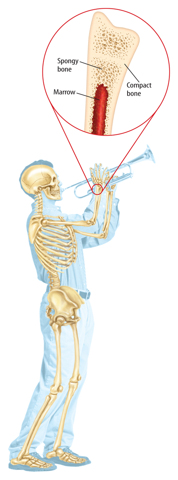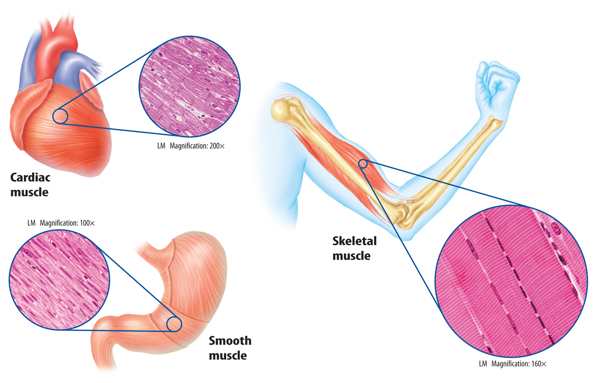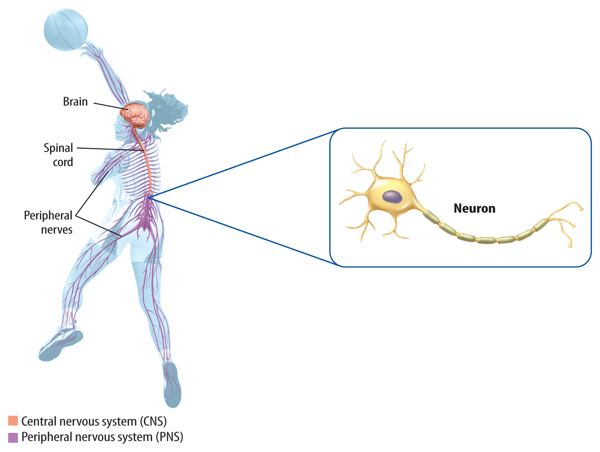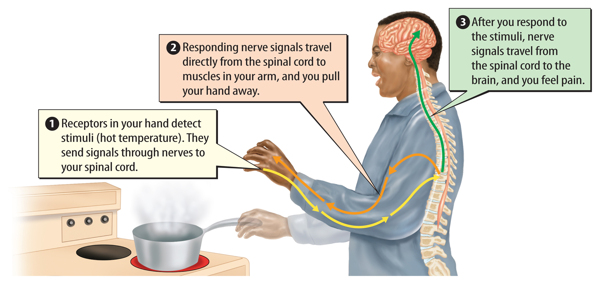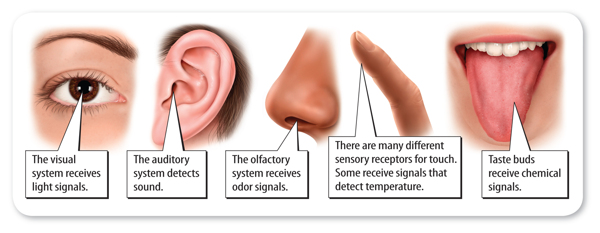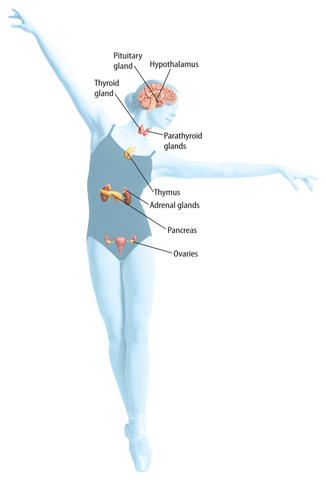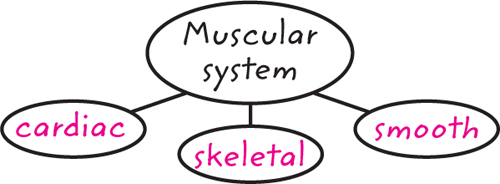The muscular system moves the body.
The body has over 600 muscles.
The body has over 600 muscles.
Muscle: an organ that relaxes and contracts to allow movement.
Links
The Muscular System works with the Skeletal System
to form the
Musculoskeletal System.
Musculoskeletal System Video Kidport - Muscles
Learn More about Muscles Here
Muscles, Muscles, More Muscles Human Body Systems Study
The Bone Song
Functions of the Skeletal System
1. movement
2. protection
3. structure
4. storage of minerals
5. blood cell production
Function of Muscles
The two main functions of muscle are
1. to produce movement
2. to maintain posture
The muscular system also helps the body
3. generate heat
Types of muscles.
Skeletal muscles are involved in bodily locomotion.
Smooth muscles are involved in digestion
Cardiac muscles are involved within the heart.
Over all, the muscles are always involved in moving something.
Muscle Movements
Involuntary - Automatically move without you knowing.
Voluntary- Brain sends message to muscle. You control the movements
Voluntary- Brain sends message to muscle. You control the movements
Skeletal muscles involve moving the body. They are voluntary muscles.
Cardiac muscles involve moving blood. They are involuntary muscles.
Smooth muscles are involved with moving material in the bowels. They are involuntary muscles.
Cardiac muscles involve moving blood. They are involuntary muscles.
Smooth muscles are involved with moving material in the bowels. They are involuntary muscles.
These muscles have distinctive attributes.
Skeletal muscles are attached to bone with tendons. They are striated, they apear to have layers.
Smooth muscles act together with other smooth muscles to coordinate the movement of stuff through the bowels. Smooth muscles are not striated, they are thin and line various organs.
Cardiac muscles are in the heart, The heart is an organ that is made of smooth muscle tissue specifically cardiac muscle tissue.
Muscle tissue is a specialized tissue that can contract.
Tendons and Ligaments (Connective Tissue)
As fascinating as they are, muscles alone can't do the job. At every joint, tendons and ligaments also help out. Muscles wouldn't be very useful alone because they don't directly connect to the bone, so even if they contract, they wouldn't be moving anything. Instead, muscles are connected to tendons, when themselves are connected to the bones. When the muscles contract, they pull on the tendons, which in turn pull on the muscles, and that causes movement.But without ligaments, that movement wouldn't be too useful because it would not be directed movement. Without ligaments, instead of bones bending or rotating about each other when muscles contract, they would slide by each other. Ligaments are what hold the bones together.
When tendons and ligaments are pulled beyond their normal range, a sprain occurs.
Tendons connect muscle to bone.
Ligaments connect bone to bone.
Cartilage acts as a shock absorber between bones.
Cartilage is a flexible connective tissue found in many areas in the bodies of humans and other animals, including the joints between bones, the rib cage, the ear, the nose, the bronchial tubes and the intervertebral discs. It is not as hard and rigid as bone but is stiffer and less flexible than muscle.
Energy changes when your muscles contract...
Eating food supplies your cells with the neccessary nutrients to perform and create ATP or energy.
This is a chemical reaction, turning food into energy...(remember cellular respiration?)
The muscles then use the energy or ATP to move, this is mechanical energy
Also the muscles create HEAT when they move ....This is thermal energy
The muscular system contributes to approximately 40%
of the body’s overall weight (an average sized individual.)
of the body’s overall weight (an average sized individual.)
Myology is the study of muscles
How do the muscles help your body maintain its temperature?
Muscles play a significant role in the body’s ability to maintain a constant temperature regardless of the temperature which surrounds it. Metabolism, which is the process of turning food into energy, releases heat, which in turn helps to maintain a regulated body temperature. Muscles, which comprise approximately 40% of the body’s weight, carry enough impact on the human body based solely on their mass to be the prime source of the body’s ability to heat itself and maintain a steady constant temperature. The state of chronic muscle fiber activity maintains body temperature and the state of strenuous muscular activity increases body temperature, encouraging the human body to produce sweat to cool the temperature.
Have you ever had to open your mouth for a dental checkup as shown in the photo above? The human body can move in many different directions and perform a wide variety of tasks. It is able to do things that require many parts of the body to move, such as shooting a basketball into a hoop or swimming a lap in a pool. The human body also can remain very still, such as when posing for a picture or balancing on one leg.
In this lesson, you will read more about two organ systems—the skeletal system and the muscular system—that give the body structure, help the body move, and protect other organ systems.
The Skeletal System
The skeletal system has four major jobs. It protects internal organs, provides support, helps the body move, and stores minerals. The skeletal system is mostly bones. Adults have 206 bones. Ligaments, tendons, and cartilage are also parts of the skeletal system.
Storage The skeletal system is also an important storage site for minerals such as calcium. Calcium is essential for life. It has many functions in the body. Muscles require calcium for contractions. The nervous system requires calcium for communication. Most of the calcium in the body is stored in bone. Calcium helps build stronger compact bone. Cheese and milk are good sources of calcium.
1.  Reading Check What mineral is stored by the skeletal system?
Reading Check What mineral is stored by the skeletal system?
 Reading Check What mineral is stored by the skeletal system?
Reading Check What mineral is stored by the skeletal system?
Support Without a skeleton, your body would look like a beanbag. Your skeleton gives your body structure and support, as shown in Figure 1. Your bones help you stand, sit up, and raise your arms to play an instrument, such as a trumpet.
Protection Many of the bones in the body protect organs that are made of softer tissue. For example, the skull protects the soft tissue of the brain, and the rib cage protects the soft tissue of the lungs and heart.
Movement The skeletal system helps the body move by working with the muscular system. Bones can move because they are attached to muscles. You will read more about the interaction of the skeletal system and the muscular system later in this lesson.
Bone Types Bones are organs that contain two types of tissue. Compact bone is the hard outer layer of bone. Spongy bone is the interior region of bone that contains many tiny holes. As shown in Figure 1, spongy bone is inside compact bone. Some bones also contain bone marrow. Recall that bone marrow is a part of the lymphatic system and makes white blood cells.
2.  Reading Check How do the two types of bone tissue differ?
Reading Check How do the two types of bone tissue differ?
 Reading Check How do the two types of bone tissue differ?
Reading Check How do the two types of bone tissue differ?
The Muscular System
You might already know that there are muscle cells in your arms and legs. But did you know that there are muscle cells in your eyes, heart, and blood vessels? Without muscle cells you would not be able to talk, write, or run.
As shown in Figure 2, muscle cells are everywhere in the body. Almost one-half of your body mass is muscle cells. These muscle cells make up the muscular system. By working together, they help the body move.
The muscular system is made of three different types of muscle tissue—skeletal muscle, cardiac muscle, and smooth muscle. Skeletal muscle works with the skeletal system and helps you move. Tendons connect skeletal muscles to bones. Skeletal muscle also gives you the strength to lift heavy objects. Skeletal muscles are also called voluntary muscles, which are muscles that you can consciously control.
Another type of muscle tissue is cardiac muscle. Cardiac muscle is only in the heart. It continually contracts and relaxes and moves blood throughout your body.
Smooth muscle tissue moves materials through your body. Smooth muscle tissue is in organs such as the stomach and the bladder. Blood vessels also have smooth muscle tissue.
Cardiac muscle and smooth muscle are involuntary muscles, which are muscles you cannot consciously control. These muscles contract and retract without you thinking about it. This helps keep blood moving through your circulatory system and food moving through your digestive system.
3. Key Concept Check What systems help the body move?
The Nervous System and the Endocrine System
Sunday, November 17, 2013 | By Traci Sandoval
Control and Coordination - Our Neurons
LinksHuman Body Systems Song
Click here for the Powerpoint
The Brain Videos...Watch them all! Nervous System Song Video on Neurons
Bill Nye on the Brain human nervous system Watch a video here Synapse Video Here
LinksHuman Body Systems Song
Click here for the Powerpoint
The Brain Videos...Watch them all! Nervous System Song Video on Neurons
Bill Nye on the Brain human nervous system Watch a video here Synapse Video Here
How does the nervous system interact with other body systems? Click here!
Fight or Flight Responses Auditory Illusions Optical Illusions 1 Optical Illusions 2 Optical Illusions 3 Auditory Illusions The Endocrine System Endocrine2 How the ear works
Optical Illusions 4 The incredible human machine
The nervous system, shown in Figure 3, and the endocrine system, which you will read about later, receive and process information about your internal and external environments. These two systems control many functions, including movement, communication, and growth, by working with other systems in the body and help maintain homeostasis.
Fight or Flight Responses Auditory Illusions Optical Illusions 1 Optical Illusions 2 Optical Illusions 3 Auditory Illusions The Endocrine System Endocrine2 How the ear works
Optical Illusions 4 The incredible human machine
The nervous system, shown in Figure 3, and the endocrine system, which you will read about later, receive and process information about your internal and external environments. These two systems control many functions, including movement, communication, and growth, by working with other systems in the body and help maintain homeostasis.
1. Key Concept Check How does the body respond to changes in its environment?
Figure 3 The brain and the spinal cord form the central nervous system. All other nerves are part of the peripheral nervous system that extends throughout the entire body.
The Nervous System
The nervous system is a group of organs and specialized cells that detect, process, and respond to information. The nervous system constantly receives information from your external environment and from inside your body. It can receive information, process it, and produce a response in less than 1 second.
Nerve cells, or neurons, are the basic units of the nervous system. Neurons can be many different lengths. In adults, some neurons are more than 1 m long. This is about as long as the distance between a toe and the spinal cord.
The nervous system includes the brain, the spinal cord, and nerves. The brain and the spinal cord form the central nervous system. Nerves outside the brain and the spinal cord make up the peripheral nervous system.
Processing Information The central nervous system is protected by the skeletal system. Muscles and other organs surround the peripheral nervous system. Information enters the nervous system through neurons in the peripheral nervous system. Most of the information then is sent to the central nervous system for processing. After the central nervous system processes information, it signals the peripheral nervous system to respond.
Voluntary and Involuntary Control The body carries out many functions that depend on the nervous system. Some of these functions such as breathing and digestion are automatic, or involuntary. They do not require you to think about them to make them happen. The nervous system automatically controls these functions and maintains homeostasis.
Most of the other functions of the nervous system are not automatic. They require you to think about them to make them happen. Tasks such as reading, talking, and walking are voluntary. These tasks require input, processing, and a response.
Reflexes Have you ever touched a hot pan with your hand? Touching a hot object sends a rapid signal that your hand is in pain. The signal is so fast that you do not think about moving your hand; it just happens automatically. Automatic movements in response to a signal are called reflexes. The spinal cord receives and processes reflex signals, as shown in Figure 4. Processing the information in the spinal cord instead of the brain helps the body respond more quickly.
The Senses Humans detect their external environment with five senses—vision, hearing, smell, touch, and taste—as shown in Figure 5. Each of the five senses has specific neurons that receive signals from the environment. Information detected by the senses is sent to the spinal cord and then to the brain for processing and a response. Responses depend on the specific signal detected. Some responses cause muscles to contract and move such as when you touch a hot surface. The aroma of baking cookies might cause your mouth to produce saliva.
The Endocrine System
How tall were you in first grade? How tall are you now? From the time you were born until now, your body has changed. These changes are controlled by the endocrine system, shown in Figure 6. Like the nervous system, the endocrine system sends signals to the body. Chemical signals released by the organs of the endocrine system are called hormones. Hormones cause organ systems to carry out specific functions.
Why does your body need two organ systems to process information? The signals sent by the nervous system travel quickly through neurons. Hormones travel in blood through blood vessels in the circulatory system. These messages travel more slowly than nerve messages. A signal sent by the nervous system can travel from your head to your toes in less than 1 s, but a hormone will take about 20 s to make the trip. Although hormones take longer to reach their target organ system, their effects usually last longer.
Many of the hormones made by the endocrine system work with other organ systems and maintain homeostasis. For example, parathyroid hormone works with the skeletal system and controls calcium storage. Insulin is a hormone that is released from the pancreas that signals the digestive system to control nutrient homeostasis. Other hormones, such as growth hormone, work with many organ systems to help you grow.
2.  Reading Check How do hormones help the body maintain homeostasis?
Reading Check How do hormones help the body maintain homeostasis?
 Reading Check How do hormones help the body maintain homeostasis?
Reading Check How do hormones help the body maintain homeostasis?
Figure 6 The endocrine system uses hormones to communicate with other organ systems.
Lesson Assessment
Use Vocabulary
1. Distinguish between compact bone and spongy bone.
2. A chemical signal that is released by the endocrine system is a(n) __________.
3. Use the term neuron in a sentence.
Understand Key Concepts
4. An automatic movement in response to a signal is called a
A.hormone.
B.muscle.
C.neuron.
D.reflex.
5. Compare the role of tendons in helping the skeletal system and the muscular system work together
to a bridge between two cities.
to a bridge between two cities.
6. Infer How does the skeletal system protect other organ systems in the body?
7. Which part of the nervous system is shown below?
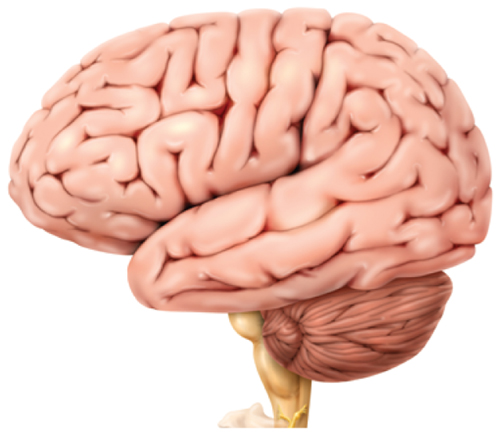

A.brain
B.neuron
C.peripheral nerve
D.spinal cord
8. Which is NOT a type of muscle tissue?
A.cardiac
B.lymphatic
C.skeletal
D.smooth
9. Which is a part of the skeletal system?
A.ligament
B.spleen
C.thymus
D.trachea
Interpret Graphics
10. Summarize Copy and fill in the graphic organizer below to show the three types of muscle tissue.
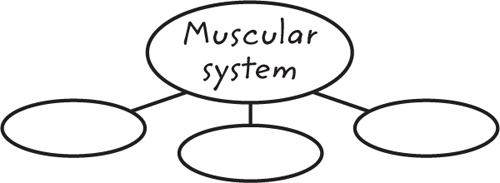

11. Predict the effect of having less compact bone than normal on the strength of the skeletal system by examining the figure below.


Critical Thinking
12. Hypothesize What would be the effect of losing one’s sight on the ability to digest food? Explain your answer.
13. Hypothesize how an injury to the spinal cord might affect the ability of the nervous system to sense and respond to a change in the environment.
14. Assess how the nervous system helps the muscular system control heart rate, digestion, and respiration.
15. Assess the role of the skeletal system in the storage of nutrients.
16. Name two hormones produced by the endocrine system and describe how they work with other organ systems and maintain homeostasis.
17. Identify the main functions of the skeletal, muscular, nervous, and endocrine systems.
Can you say the color name not read the word?

That's all for now....
Can you say the color name not read the word?
That's all for now....
Mrs. Sandoval

